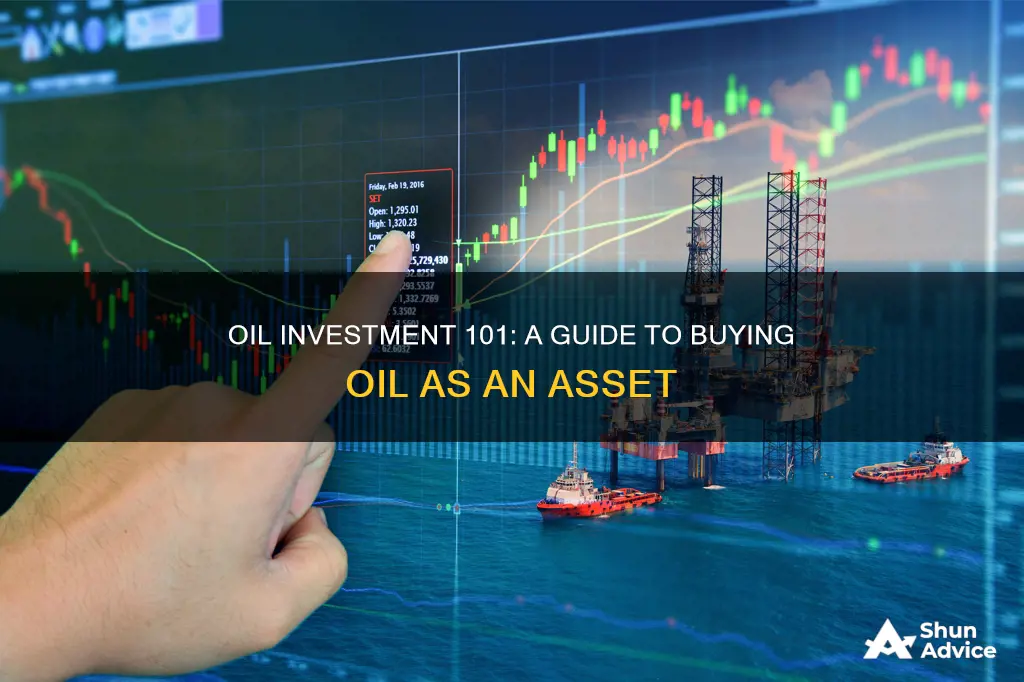
Investing in oil can be done in a number of ways, including direct and indirect investments. Direct exposure to oil can be gained through the purchase of oil futures, oil options, or commodity-based exchange-traded funds (ETFs). Indirect exposure can be achieved by investing in energy sector ETFs, energy sector mutual funds, or stock in individual oil companies. Oil is a volatile commodity and investing in it carries additional risks that investors should be aware of before buying.
| Characteristics | Values |
|---|---|
| Investment options | Oil stocks, oil mutual funds, oil futures, oil options, commodity-based exchange-traded funds (ETFs), energy-sector ETFs, energy-sector mutual funds, oil company stocks |
| Oil price influencers | Supply and demand, the Organisation of the Petroleum Exporting Countries (OPEC), global events, economic conditions, technological shifts |
| Oil market investment options | Derivatives markets, futures and options contracts, stocks of oil drilling and service companies, energy-sector ETFs, energy-sector mutual funds |
| Oil types | West Texas Intermediate (WTI), Brent, light, sweet |
| Oil investment risks | Volatility, complexity, ethical concerns, accidents, sudden and dramatic price fluctuations, numerous risks |
| Oil investment benefits | Potential for returns, diversification, inflation hedge |
What You'll Learn

Oil futures and options
The idea with futures and options trading is that you never actually end up with the oil yourself. There is usually a healthy market of buyers who will take a futures or options contract off your hands. But in spring 2020, when the coronavirus pandemic was starting, the oil futures market collapsed. Oil refineries weren't buying as much oil, and there ended up being a backlog. Investors trading oil futures and options couldn't find anyone to buy their contracts and dropped their prices to entice buyers. In April 2020, oil prices temporarily fell into the negative: The futures contract for West Texas crude oil was minus $37.63 a barrel. In other words, investors were willing to pay to get rid of their contracts. Oil futures and options have since rebounded, but that scenario may give investors some pause.
If you're interested in trading futures and options, proceed with caution.
One of the most liquid oil futures contracts is CME Group West Texas Intermediate (WTI) Light Sweet Crude Oil futures. WTI Crude Oil futures and options are the most efficient way to trade the largest light, sweet crude oil blend. Over 1 million contracts of WTI futures and options trade daily, with approximately 4 million contracts of open interest. WTI is the go-to measure for the world oil price, with the U.S. producing and exporting record amounts of crude oil.
Options on futures contracts include American, European, Asian (APO), calendar spread (CSO) and ARB options for crude and refined products.
SIPs: Invest Now or Later?
You may want to see also

Oil ETFs and ETNs
Oil ETFs
Oil ETFs, or exchange-traded funds, are baskets of securities that either track the price of oil as a commodity or contain oil stocks. They are an easy way to invest in oil markets, but they do carry risk. Oil ETFs can be purchased through an online brokerage account or a full-service broker.
The best-performing oil ETFs based on five-year performance include the United States Brent Oil Fund LP, the United States Oil Fund ETF, and the ProShares K-1 Free Crude Oil Strategy ETF. These ETFs track the price of oil through benchmarks such as the Brent Crude Oil or West Texas Intermediate (WTI) benchmarks.
Oil ETNs
Oil ETNs, or exchange-traded notes, are similar to oil ETFs in that they are traded on securities exchanges. However, a key difference is that ETFs are investment companies registered by the U.S. Securities and Exchange Commission, and they own the underlying assets that investors purchase a part of. On the other hand, ETNs do not own an underlying portfolio of assets and are instead unsecured debt obligations, making them generally riskier investments than ETFs.
Some examples of oil ETNs include the iPath Series B S&P GSCI Crude Oil Total Return Index ETN and the Credit Suisse X-Links Crude Oil Shares Covered Call ETN.
Investing 101: Classes to Help You Master the Market
You may want to see also

Energy stocks, equity ETFs and mutual funds
Energy Stocks
Energy stocks are shares of companies involved in the extraction and production of petroleum. You can buy the stocks of oil drilling and service companies, but it's important to research a company thoroughly before investing.
Equity ETFs
Energy exchange-traded funds (ETFs) are an easy way to invest in the energy sector. They offer a cross-section of the industry, reducing your risks by diversifying your investment across the sector. ETFs are also a liquid way to invest in oil.
- Energy Select Sector SPDR Fund (XLE)
- IShares US Energy ETF
- IShares US Oil & Gas Explor & Prod ETF
- IShares US Oil Equipment & Services ETF
- Fidelity MSCI Energy ETF
- VanEck Oil Services ETF (OIH)
- IShares Global Clean Energy ETF
- Invesco S&P 500 Equal Weight Energy ETF
- IShares Global Energy ETF (IXC)
Mutual Funds
Mutual funds are another way to gain exposure to oil. They offer diversification within the energy sector, reducing risk.
Some of the largest mutual funds focused on energy include:
- Vanguard Energy Fund Investor Shares (VGENX)
- Fidelity Select Energy (FSENX)
- IShares Global Energy Sector Index Fund (IXC)
- T. Rowe Price New Era Fund (PRNEX)
- SPDR S&P Oil & Gas Exploration & Production ETF (XOP)
- IShares Dow Jones U.S. Oil & Gas Exploration & Production Index Fund (IEO)
- Invesco Dynamic Energy Exploration & Production Portfolio (PXE)
- VanEck Vectors Oil Refiners ETF (CRAK)
- VanEck Vectors Oil Services ETF (OIH)
Retirement Reinvented: Exploring the Best Investment Strategies
You may want to see also

Volatility and risk
The oil market is highly volatile, with large price fluctuations occurring daily. Oil prices are determined by supply and demand, but OPEC (Organization of the Petroleum Exporting Countries) also has some control over supply. The price of oil is largely uncorrelated to stock market returns or the direction of the US dollar.
Oil is a crucial resource globally, providing the majority of energy for transportation and raw materials for manufacturing. As the process of producing oil is lengthy, consumers and suppliers are slow to adjust consumption and production when prices fluctuate. This means that oil prices must move further to rebalance markets following disruptions such as a drop in demand due to a pandemic or an interruption in supply due to war or economic sanctions.
Oil volatility can negatively impact economic growth and development. An increase in oil volatility can lead to a rise in oil inventories and a reduction in oil consumption, investment, and employment. It can also negatively impact aggregate equity prices, particularly in industries with negative exposures to oil price risk.
Oil price shocks can have significant effects on economic growth and welfare worldwide. Positive oil price shocks can increase production costs and restrict output, with price increases passed on to consumers. Higher prices for gasoline and electricity also increase the cost of living, impacting households, especially the poor. These impacts can have knock-on effects on various economic indicators such as employment, trade balance, inflation, public accounts, stock market prices, and exchange rates.
Oil price volatility can reduce planning horizons, causing firms to postpone investments and requiring expensive resource reallocation. It can also make formulating robust national budgets more challenging, as importing countries face uncertainty regarding import costs and fuel subsidy levels, while exporters face volatile revenues.
Oil is a limited resource, and the demand for it may increase as emerging market economies industrialize. However, the discovery of new oil reserves has been declining since 2014, and oil exploration budgets have been cut. As a result, the prospects of future oil supply are highly uncertain.
Investing in oil comes with risks due to its volatility. Oil stocks and funds can provide diversification, but investing in oil futures is often considered riskier. Oil-related investments may be unsuitable for those seeking more sustainable options, as they are graded using ESG (environmental, social, and governance) factors.
Why People Invest: Unlocking Motivations
You may want to see also

Oil companies and oil stocks
Oil stocks are shares of companies involved in the extraction and production of petroleum. There are several ways to invest in oil stocks, including buying shares of individual oil companies, investing in oil mutual funds or exchange-traded funds (ETFs), or trading oil futures and options contracts. Here is a more detailed look at some of these options:
Oil Company Stocks
One simple way to invest in oil is by purchasing stocks of oil drilling and service companies. Examples of major oil companies include:
- Exxon Mobil Corporation
- Petróleo Brasileiro S.A. - Petrobras
- Canadian Natural Resources Limited
- Schlumberger Limited
- Enterprise Products Partners L.P.
- Marathon Petroleum Corporation
- Occidental Petroleum Corporation
- The Williams Companies, Inc.
- Valero Energy Corporation
- TC Energy Corporation
- Cheniere Energy, Inc.
- Baker Hughes Company
- Conocophillips
- TotalEnergies
- BP
- Halliburton
Energy-Sector ETFs and Mutual Funds
Investors can also gain indirect exposure to oil by investing in energy-sector ETFs and mutual funds. These funds invest in a basket of energy-related stocks, providing diversification within the energy sector. Examples of energy-sector ETFs and mutual funds include:
- IShares Global Energy Sector Index Fund (IXC)
- SPDR S&P Oil & Gas Exploration & Production ETF (XOP)
- IShares Dow Jones U.S. Oil & Gas Exploration & Production Index Fund (IEO)
- Invesco Dynamic Energy Exploration & Production Portfolio (PXE)
- VanEck Vectors Oil Refiners ETF (CRAK)
- VanEck Vectors Oil Services ETF (OIH)
- Energy Select Sector SPDR Fund (XLE)
- Vanguard Energy Fund Investor Shares (VGENX)
- Fidelity Select Energy (FSENX)
Oil Futures and Options
A more advanced and risky way to invest in oil is through oil futures and options contracts. These are agreements to buy or sell a set amount of oil at a set price on a future date. Oil futures and options allow investors to speculate on the price of oil, but they can be volatile and are not suitable for all investors.
Renting vs. Investing: The Financial Dilemma
You may want to see also
Frequently asked questions
There are several ways to invest in oil, including direct and indirect investments. Direct investments include oil futures, oil options, and commodity-based exchange-traded funds (ETFs). Indirect investments include energy sector ETFs, energy sector mutual funds, or stock in individual oil companies.
Investing in oil carries additional risks compared to other investments. These risks include world events, oil price wars, government regulation, technological shifts (such as the move towards electric vehicles), cyclicality, and economic conditions. These factors can all impact the price of oil, which is already highly volatile. Oil investments are therefore not suitable for risk-averse investors.
Oil investments offer the potential for high returns due to the volatility of oil prices. Oil can also be used as a hedge against inflation, as its price often moves independently of stock market returns or the US dollar. Additionally, the demand for oil is expected to remain high in the near future, despite the shift towards renewable energy sources.
To invest in oil, you will need a brokerage account. You can then choose from a variety of investment vehicles, such as oil stocks, oil ETFs, oil futures, or oil options. It is recommended that you consult an independent financial advisor (IFA) to understand the level of risk you can afford to take and seek advice from a specialist oil broker or stockbroker for more in-depth tips on the investment itself.







